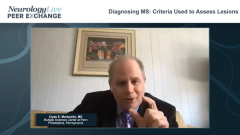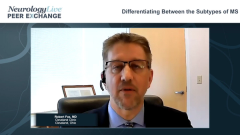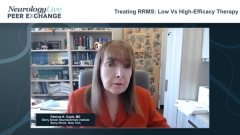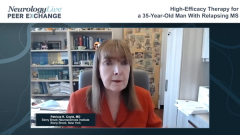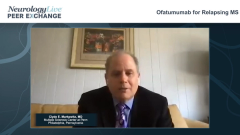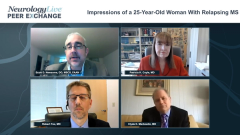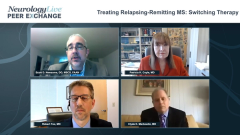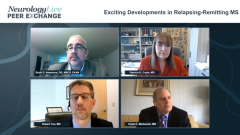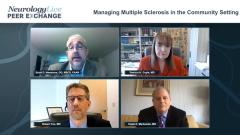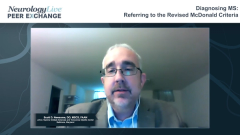
Diagnosing MS: Criteria Used to Assess Lesions
Clyde E. Markowitz, MD, comments on the growing role of magnetic resonance imaging to help diagnose multiple sclerosis and highlights characteristics of lesions he looks at during a diagnostic evaluation.
Episodes in this series

Scott D. Newsome, DO, MSCS, FAAN: Clyde, Pat just gave us a 50,000-foot view on the revised 2017 McDonald Diagnostic] Criteria for Multiple Sclerosis. Could you give us more information about the number of lesions needed to help fulfill dissemination in space? The reason I bring that up is because I remember in residency or maybe a bit before then, trying to count the 9 T2 lesions from the old iteration of the McDonald criteria, which were quite painful. It is a lot easier for clinicians to be able to do that counting. Could you take us through that?
Clyde E. Markowitz, MD: Sure. There are a couple of pieces to this that are of interest. First is the magic No. 9 that we used for many years seemed to be able to give us some specificity. The problem we are dealing with is that you have fewer requirements for the number. Let’s say 2. You have to be more specific about the shape and location of those lesions. Ultimately in the future, we will be able to say a lesion has a small central vein within it, which may be more specific individually, but as you know, we are doing studies looking at a typical 50-year-old person who gets an MRI scan who has some spots on their brain, and you are trying to figure out if this is specific for MS [multiple sclerosis]. You may have somebody who presents with an abnormal MRI scan who has 0 complaints, and you are asking if this is specific even though you have no idea whether this is ultimately going to be MS.
The criteria have been specific about the shape of the lesions and their location: periventricular, juxtacortical, etc. There is an advantage in that you do not have to count up all the lesions, and you can even use the symptomatic lesions as part of the diagnostic requirements. It also puts a little more of a challenge on us to be able to say that those are specific for MS because we do not have the same number that we are dealing with. You have to be good at correlating the location, shape, and size to be able to say that those are specific for MS. I love the idea that we do not have to be numerically saying, “You have 9.” What happened if you got only 8 or 6? You would not be able to use that as criteria. Now that you are able to take that along with the clinical phenotype and now that you have more people getting spinal taps, it adds a bit more specificity to it. All of that is helping us.
I will say that we have some more room to go because now everybody fits into that criteria even in today’s world. A lot of us use this, and we can say that this is classic for MS, and therefore, I am happy and do not need to go any further with this. There are plenty people who have only 1 lesion on their brain MRI, and you do not see any abnormality in their brain stem or their spinal cord, which still creates a problem for us as clinicians because you may still feel that this is somebody who is clinically consistent with MS, but they do not meet the absolute criteria at this point. This is an evolving conversation. It is going to continue to evolve over time.
Robert Fox, MD: It does, and it is important to go back to Pat’s point earlier, which is that these are clinical diagnoses. Counting the lesions and seeing the locations needs to be within the context of a clinical syndrome that is consistent with MS. These criteria are not applicable to any old MRI that happens to get captured on an MRI machine. It needs to be in the context of a clinical syndrome that appears consistent with MS. That is key to the overall context before we start applying these various criteria.
Clyde E. Markowitz, MD: True, Bob.
Scott D. Newsome, DO, MSCS, FAAN: That is absolutely right. That is taking the words out of my mouth.
Clyde E. Markowitz, MD: True, but there is an important piece to that. We have continually moved earlier and earlier in the diagnostic world of MS because we have learned from many studies that we want to treat these people as early as possible. MRI has given us the possibility of looking into the earliest-possible window for the patients we see. In the future these people are going to have biomarkers, whether it’s MRI, whether it’s OCT [optical coherence tomography], whether it’s neurofilament light chain—whatever that is going to keep pushing us earlier to the point where MRI may become the test that is going to generate the diagnosis without a clinical piece. At some point, you are going to say, “I have enough data here by MRI and some of these biomarkers to be able to say this is going to evolve clinically to MS. Let’s go ahead and consider getting them on therapies.” We are not there yet. Do you think we are going to get there?
Scott D. Newsome, DO, MSCS, FAAN: That is a pretty bold statement. That is like in RIS [radiologically isolated syndrome] and saying that all patients with RIS are going to go on to fulfill criteria, and you then have to think about treating it.
Thank you for watching this Neurology Live® Peer Exchange. If you enjoyed the content, and I hope you did, please subscribe to our e-newsletters to receive upcoming Peer Exchanges and other great content right in your in-box.
Transcript Edited for Clarity
Newsletter
Keep your finger on the pulse of neurology—subscribe to NeurologyLive for expert interviews, new data, and breakthrough treatment updates.

